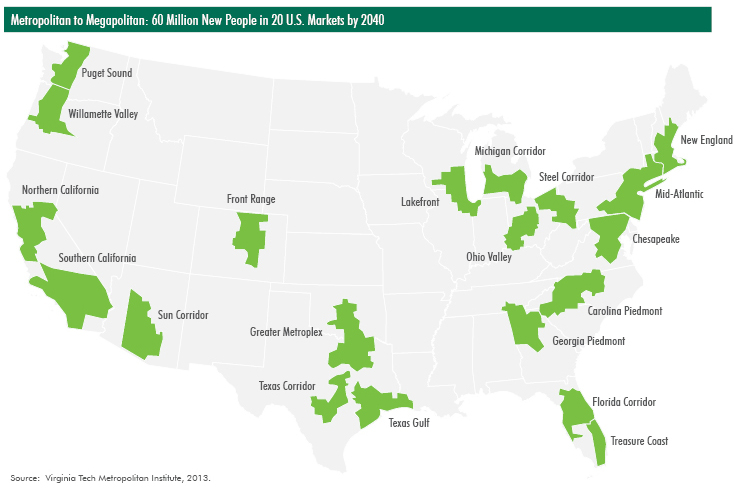The WPJ
THE WORLD PROPERTY JOURNALReal Estate Facts Not Fiction
Commercial Real Estate News

Trans-Pacific Shipping Costs, Growing 'Megapolitans' Impacting U.S. Industrial Markets
Commercial News » North America Commercial News Edition | By Michael Gerrity | August 1, 2014 9:57 AM ET
According to the latest report from CBRE Group, Inc., Transportation Cost Equivalence Line: East Coast vs. West Coast Ports, the ever-evolving global supply chain is prompting distribution companies that process freight shipments between the U.S. and Asia to optimize their U.S. industrial real estate portfolios to increase efficiencies and cost savings.
These companies are heavily scrutinizing transportation costs in East Coast and West Coast seaports--and inland cities with strong transportation links--locating facilities in markets best able to serve established and emerging "megapolitan" areas in a quick, cost-effective manner.
"Distribution and fulfillment users need a real estate footprint that allows them to move freight through the U.S. transportation network as fast as economically feasible," said Scott Marshall, Executive Managing Director, Industrial Services, Americas, CBRE. "Future location decisions will largely be driven based on population growth--the East Coast and West Coast ports with the infrastructure and transportation links to serve the largest and fastest growing regions in the country will also be home to strong-performing industrial real estate markets."
Between 2005 and 2040, the U.S. population is expected to grow by 100 million people--60 million of which are expected to reside within 20 markets characterized as megapolitans. These megapolitan markets comprise cities and counties linked by shared transportation networks, labor markets and/or water supplies. These 20 megapolitan areas, which can be further combined into 10 clusters, are projected to house about two-thirds of the U.S. population by 2040 and will capture the lion's share of total investment dollars spent on development and growth.
The impact of population shifts on supply chain networks and industrial real estate in the coming years will be significant. However, the additional volume moving through these megapolitan regions could result in increased congestion and loss of productivity. As such, the continued investment in transportation infrastructure is crucial.
In order to capitalize on the greater container volume that will soon traverse the expanded Panama Canal, many seaports have recently invested millions in infrastructure, creating alternative transportation solutions including short haul rail and barge systems to accommodate post-Panamax ships. However, the expansion of the Panama Canal is not expected to have a major impact in the movement of freight within the U.S., as separate strategies are required for high-value, time-sensitive freight (quicker delivery) and for low-value, low-cost freight (cost effective delivery).

Sign Up Free | The WPJ Weekly Newsletter
Relevant real estate news.
Actionable market intelligence.
Right to your inbox every week.
Real Estate Listings Showcase
Related News Stories
Commercial Real Estate Headlines
- 2025 Prediction: U.S. Commercial Investment Recovery Expected to Gain Traction
- Holiday Retail Sales for 2024 to Hit Record $1 Trillion
- Tech, AI Industries Drive Largest Share of Office Leasing Activity in U.S.
- Commercial Real Estate Lending in U.S. Enjoys Strong Growth in Q3
- U.S. Multifamily Market Begins Recovery in Q3
- Commercial Investment in Japan Spikes 24 Percent Annually in Q3
- Despite Return-to-Office Mandates, U.S. Office Vacancies Continue to Rise
- PROPSIG Tech Startup Acquired by World Property Data
- U.S. Commercial Mortgage Debt Hits $4.7 Trillion in Q2 as Delinquencies Increase
- Hong Kong Class A Office Rents Continue to Downtick in Mid-Summer
- U.S. Office Landlords Tenant Concessions Decline for First Time in 4 Years
- U.S. Commercial Mortgage Originations Spike 27 Percent in Q2 Over Q1
- Phnom Penh's Commercial Office, Retail Markets Face Slowdowns in 2024
- Global Edge Data Center Market to Hit $300 Billion by 2026
- Commercial Property Transactions in Japan Dive 25 Percent Annually in Q2
- Delinquency Rates for U.S. Commercial Property Loans Downticks in Q2
- Megawarehouse Lease Deals in U.S. Increase in 2024
- Office Tenants' Flight to Quality Buildings Increases in 2024
- Commercial Lending in Japan Upticks 6 Percent Annually in Q1
- AI Driving Significant Global Data Center Growth in 2024
- Total U.S. Commercial Mortgage Debt Rises to $4.7 Trillion in Q1
- U.S. Commercial Mortgage Delinquencies Rise in Early 2024
- Asia Pacific Office Sector to Further Reprice Throughout 2024
- U.S. Retail Foot Traffic to Surpass Pre-Pandemic Levels by 2025
- Commercial Real Estate Lending in U.S. Slowed in First Quarter
- Japan Commercial Property Investment Volume Jumps 7 Percent in Q1
- Asia Pacific Commercial Property Investment Leads the World, Spikes 13 Percent
- Driven by High Rates, U.S. Commercial Lending Imploded 47 Percent in 2023
- After Two Year Slump, Prime Multifamily Metrics Uptick in U.S.
- Commercial Co-Broker Commissions Not Affected by NAR-DOJ Settlement, Yet
- U.S. Office Buildings with Upscale Tenant Amenities Still Enjoy Premium Rents in 2024
- U.S. Commercial, Multifamily Mortgage Delinquency Rates Uptick in Q4
- U.S. Commercial Mortgage Debt Continued to Rise in 2023, Hits $4.7 Trillion
- Nonresidential Construction Spending in the U.S. Falls Sharply in January
- U.S. Multifamily Construction Starts to Decline in 2024
- Commercial Mortgage Lending in U.S. Shows Signs of Stabilization in Late 2023
- Architecture Billings Decline in December as Soft Business Conditions Persist
- Government Sector Claimed Largest Portion of 100 Biggest U.S. Office Leases Signed in 2023
- U.S. Commercial, Multifamily Borrowing Dives 25 Percent Annually in Late 2023
- Record High Multifamily Construction Deliveries Drive Vacancy Rates Higher
Reader Poll
Marketplace Links
This website uses cookies to improve user experience. By using our website you consent in accordance with our Cookie Policy. Read More





